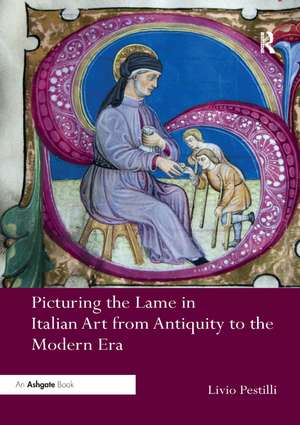Picturing the Lame in Italian Art from Antiquity to the Modern Era
Autor Livio Pestillien Limba Engleză Paperback – 23 mai 2019
Preț: 388.04 lei
Nou
Puncte Express: 582
Preț estimativ în valută:
74.25€ • 79.40$ • 61.91£
74.25€ • 79.40$ • 61.91£
Carte tipărită la comandă
Livrare economică 17 aprilie-01 mai
Preluare comenzi: 021 569.72.76
Specificații
ISBN-13: 9780367200268
ISBN-10: 0367200260
Pagini: 182
Dimensiuni: 174 x 246 x 12 mm
Greutate: 0.42 kg
Ediția:1
Editura: Taylor & Francis
Colecția Routledge
Locul publicării:Oxford, United Kingdom
ISBN-10: 0367200260
Pagini: 182
Dimensiuni: 174 x 246 x 12 mm
Greutate: 0.42 kg
Ediția:1
Editura: Taylor & Francis
Colecția Routledge
Locul publicării:Oxford, United Kingdom
Cuprins
Contents:
List of plates
List of figures
Acknowledgments
Introduction
1 Classical and Early Christian precedents
2 Imago Christi
3 Parasites
4 Papal Rome
5 Exit the lame
Coda
Bibliography
Index
List of plates
List of figures
Acknowledgments
Introduction
1 Classical and Early Christian precedents
2 Imago Christi
3 Parasites
4 Papal Rome
5 Exit the lame
Coda
Bibliography
Index
Recenzii
"One of the achievements of this book is how it links changing portrayals of impairments and settings to the social attitudes of the times, thus emphasizing the social nature of disability. Early in the book, the author emphasizes this social nature by discussing the language of disability. He acknowledges the difficulties around adopting a neutral stance, settling on “lame” as a historical term, even if it is one that is not popular today."
- H-Disability
- H-Disability
Notă biografică
Livio Pestilli is Director and Professor of Art History at Trinity College-Rome Campus, Italy. He is the author of Paolo de Matteis: Neapolitan Painting and Cultural History in Baroque Europe (Ashgate, 2013).
Descriere
This study evinces that in opposition to classical artists, who manifested a lack of interest in the subject of lameness, their Early Christian counterparts depicted them, as images of the miraculous healing of the lame became a sign of acceptance and the promise of a more equitable existence in this life or the next.
